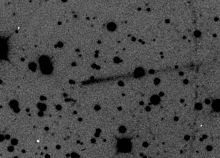354P/LINEAR
Synodic rotation period | 11.36±0.02 h | |
| Albedo | unknown | |
|---|---|---|
| ~18-20[1] | ||
| 21.3±0.6[6] | ||
354P/LINEAR,
Overview

P/2010 A2 was discovered on 6 January 2010 by
With an aphelion (furthest distance from the Sun) of only 2.6 AU,[3] P/2010 A2 spends all of its time inside of the frostline at 2.7 AU.[11] Beyond the frostline volatile ices are generally more common. Early observations did not detect water vapor or other gases.[12] Within less than a month of its discovery it was doubtful that the tail of P/2010 A2 was generated via active outgassing from sublimation of ices hidden beneath the crust.[13] Early modeling indicated that the asteroid became active in late March 2009, reached maximum activity in early June 2009, and eased activity in early December 2009.[14]

Observations with the
P/2010 A2 is likely about 150 meters (460 feet) in diameter.[12] Even when it was discovered it was suspected of being less than 500 meters in diameter.[18]
The orbit of P/2010 A2 is consistent with membership in the Flora asteroid family, produced by collisional shattering more than 100 million years ago.[12] The Flora family of asteroids may be the source of the Chicxulub (Cretaceous–Paleogene) impactor, the likely culprit in the extinction of the dinosaurs.[12]
Debris field  P/2010 A2 is likely the debris left over from a recent collision between two very small asteroids. |
Surviving fragment  Surviving fragment seen to the lower left of debris field |
See also
References
- ^ a b c Marsden, Brian G. (7 January 2010). "MPEC 2010-A32 : COMET P/2010 A2 (LINEAR)". IAU Minor Planet Center. Harvard-Smithsonian Center for Astrophysics. Retrieved 14 January 2010.
- ^ "When is a comet not a comet? Rosetta finds out". ESA News. 13 October 2010. Retrieved 15 October 2010.
- ^ a b c d "JPL Small-Body Database Browser: P/2010 A2 (LINEAR)" (last observation: 2012-10-14; arc: 2.83 years). Retrieved 3 February 2010.
- ^ JPL Horizons Observer Location: @sun (Perihelion occurs when deldot changes from negative to positive.)
- ^ . L23.
- ^ This absolute asteroidal V magnitude has been calculated using comet/asteroid magnitude analysis software "Comet for Windows" from value of R = 23.0±0.5 taken from IAU Circular No. 9109. The mean V-R color index for asteroids is +0.4±0.1.
- ^ HST Sees Evidence of Colliding Asteroids, Astronomy Today, Feb.2, 2010
- ^ Jewitt, David C. "P/2010 A2 (LINEAR): Possible Asteroid Smash". UCLA (Department of Earth and Space Sciences). Retrieved 3 February 2010.
- ^ Hergenrother, Carl W.; The Curious Case of Comet LINEAR, The Transient Sky, 10 January 2010 (1.8-m telescope on Kitt Peak)
- ^ Catalogue of Comet Discoveries, Comethunter.de
- ^ "Glossary of Astronomical Terms (Ice line)". Glossary of Astronomical Terms. Archived from the original on 14 February 2010. Retrieved 20 January 2010.
- ^ a b c d Harrington, J. D.; Villard, Ray (2 February 2010). "Suspected Asteroid Collision Leaves Trailing Debris". NASA Release : 10-029. Retrieved 3 February 2010.
- ^ Jewitt, David C. "P/2010 A2 (LINEAR): The 5th Main-Belt Comet". UCLA (Department of Earth and Space Sciences). Retrieved 20 January 2010.
- ^ Méndez, Javier (23 July 2010). "Comet P/2010 A2, an Activated Asteroid from the Main Asteroid Belt". Isaac Newton Group of Telescopes (ING). Retrieved 27 July 2010.
- S2CID 205222567.
- S2CID 4330570.
- ^ Harrington, J. D.; Weaver, Donna; Jewitt, David C. (13 October 2010). "Hubble Finds that a Bizarre X-Shaped Intruder Is Linked to an Unseen Asteroid Collision". Hubblesite newscenter STScI-2010-34. Retrieved 15 October 2010.
- Shanklin, Jonathan (18 January 2010). "BAA Comet Section : Comets discovered in 2010". Institute of Astronomy (British Astronomical Association). Retrieved 21 January 2010.
External links
- Orbital simulation from JPL (Java) / Horizons Ephemeris
- Image of Comet P/2010 A2 (Muler 12" Meade LX200)
- Suspected Asteroid Collision Leaves Odd X-Pattern of Trailing Debris (Hubble Space Telescope WFC3 2010 January 29 image)
- Hubblesite Videos (January 29 through May 29)
- NOAO/WIYN: New Camera at WIYN images an Asteroid with a Long Tail (NOAO 13-07 : 3 June 2013)
- Jewitt, David; Ishiguro, Masateru; Agarwal, Jessica (2013). "Large Particles in Active Asteroid P/2010 A2". The Astrophysical Journal. 764 (1): L5. S2CID 37325835.


